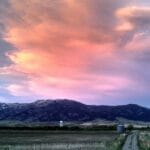Bozeman, Montana, isn’t just near the mountains; it’s practically cradled within their embrace. At an elevation of approximately 4,820 feet (1,470 meters), this vibrant city experiences the world a mile closer to the sky than those at sea level. This unique altitude isn’t just a statistic; it’s woven into the very fabric of Bozeman’s climate, culture, and the adventurous spirit that defines it.
Breathing Thin Air: Understanding Bozeman’s Altitude
Even the most basic facts about Bozeman’s elevation offer a glimpse into its complexity. While 4,820 feet is the generally accepted figure (often cited by Wikipedia and topographic-map.com), you might also encounter 4,793 feet, a figure reported by the Montana State Library, referencing USGS data. This slight discrepancy isn’t an error, but a testament to the intricacies of measuring elevation. Variances can arise from different surveying methods and reference points, adding another layer of intrigue to Bozeman’s high-altitude identity.
A Valley Defined: Bozeman’s Geographic Tapestry
Picture Bozeman nestled in a vast, high-elevation bowl—the Gallatin Valley—carved over millennia by glaciers and rivers. Now, visualize the magnificent rim of this bowl: the Bridger Mountains rising to the north-northeast, the Tobacco Root Mountains stretching to the west-southwest, the Big Belt Mountains and Horseshoe Hills to the northwest, and the striking Hyalite Peaks (part of the Gallatin Range) and Spanish Peaks (part of the Madison Range) dominating the southern horizon. These majestic ranges aren’t mere scenery; they are integral to Bozeman’s character, shaping its weather, defining its recreational opportunities, and offering breathtaking panoramic views.
The Sky’s the Limit: How Elevation Shapes Bozeman
Bozeman’s elevation is more than just a number; it’s a powerful force shaping the city’s identity.
A Climate of Extremes: From Snowy Peaks to Summer Sun
The thin air at 4,820 feet conducts a unique symphony of weather. Winters are crisp and snowy, transforming the landscape into a winter wonderland perfect for skiing and snowboarding. Summers arrive with warm sunshine, ideal for exploring the countless hiking and biking trails. But be prepared for a dramatic encore: significant temperature swings between day and night. With less atmosphere to trap heat, the ground heats up rapidly during the day and cools down just as quickly at night, a hallmark of high-altitude environments. These diurnal temperature variations add a touch of unpredictability to Bozeman’s climate, ensuring that residents and visitors alike are always on their toes.
Adventure Awaits: Recreation in the High Country
Bozeman’s reputation as an outdoor recreation mecca is inextricably linked to its elevation. The surrounding mountains offer world-class skiing at resorts like Bridger Bowl and Big Sky. Hyalite Canyon, with its frozen waterfalls and challenging ice climbs, becomes a winter climbers’ paradise. In summer, the same trails transform into havens for hikers and mountain bikers. The rivers, influenced by the high-elevation snowmelt, offer pristine waters teeming with trout, making Bozeman a fly-fishing dream. Imagine these same activities at sea level – the experience would be undeniably different. Bozeman’s altitude isn’t just a backdrop; it’s an active participant in the adventure.
Acclimatizing to the Heights: A Breath of Fresh Air, Literally
Arriving in Bozeman from lower elevations can feel like stepping onto a different planet. The thinner air, while invigorating, can also pose challenges. Altitude sickness, with symptoms ranging from mild headaches and fatigue to nausea and shortness of breath, is a possibility. This isn’t a sign of weakness, but a natural physiological response to the decreased oxygen pressure. Drinking plenty of water, avoiding alcohol initially, and easing into physical activity are crucial for acclimatization. It’s about giving your body time to adjust to the rhythm of the mountains.
Bozeman’s Allure: Beyond the Elevation
While elevation is a defining characteristic, Bozeman’s appeal extends beyond its lofty perch. Its vibrant downtown, thriving arts scene, and strong sense of community contribute to a unique atmosphere. The proximity to Yellowstone National Park, while not directly impacting elevation, adds another layer of attraction, making Bozeman a convenient gateway to one of America’s most treasured natural wonders. Discover the captivating charm and diverse array of activities that await you at Dauphin Island Alabama attractions. Explore the breathtaking beauty and unparalleled tranquility of Dater Mountain Nature Park for an unforgettable outdoor escape. These diverse elements combine to create a city that resonates with a wide range of people, from outdoor enthusiasts to those seeking a vibrant cultural hub.
The Highest City in Montana? A Tale of Two Titles
The question of Montana’s highest city isn’t straightforward. Bozeman, at approximately 4,806 feet, holds the title for the highest incorporated city. Butte, a consolidated city-county, sits higher at 5,539 feet. This distinction in municipal classification is key. Bozeman, like a standalone house, has its own independent city government. Butte, like a duplex, blends city and county governance. Both are cities, but their structures differ, influencing their place in the elevation hierarchy.
Living the High Life: A Bozeman Perspective
Bozeman’s elevation is more than just a number on a map; it’s a lived experience. It’s the crisp mountain air, the dramatic sunsets painting the peaks, and the constant reminder that nature is a powerful force. It’s about adapting to the thinner air and embracing the challenges and rewards of high-altitude living. It’s about finding a connection to the mountains that goes beyond recreation and becomes a way of life. Residents often share a deep appreciation for Bozeman’s natural beauty and the access it provides to unparalleled outdoor adventures. “It’s the mountains, the access to outdoor recreation, the fresh air, the friendly people… It’s just a great place to live.” This sentiment resonates with many, suggesting that Bozeman offers a unique blend of natural wonders and a welcoming community spirit.
While much is understood about the influence of elevation on Bozeman, ongoing research continues to explore the subtle nuances of this relationship. The complexities of microclimates, the long-term effects of high-altitude living, and the interplay between elevation and the local ecosystem are all areas of active study. This pursuit of knowledge underscores the dynamic and ever-evolving nature of Bozeman’s elevated environment.
- Unlocking 2-Letter Words with U: The Definitive Guide - April 4, 2025
- Unlock Words with the Letters THREE: Top Unscramble Tools 2025 - April 4, 2025
- Master Scrabble: X & Z Words for High Scores - April 4, 2025
















